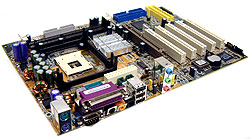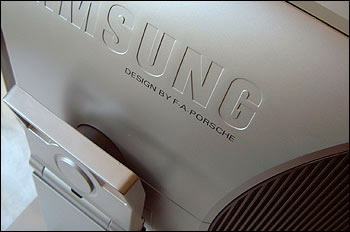|
The Race to Release Dual Channel DDR Chipsets
Hello,
Happy Halloween!
Not
only is this pumpkin carving time, but it's also the signal that our giveaway for two
Transmeta
Crusoe powered Fujitsu Lifebook P2000 notebooks is at a close. We'll be making the
draw this week, so check your email extra carefully - you just
might be one of the two
lucky winners of the PCstats.com
Newsletter contest!
We
reviewed the 2.8GHz Intel Pentium 4
processor last week, and today we are looking at the much less expensive 2.4GHz
part to see how the two compare. A good chip can make all the
difference, but a good motherboard is equally important. The Iwill P4ES
and P4GS are two examples of a Pentium 4 motherboard
anyone on a budget should be considering - they are feature packed, and
offer good performance for an i845E/G-based system.
Fast DDR memory can come in handy for
overclocking more performance oriented systems, and we checked out some
PC3200 DDR from KingMAX with surprisingly mixed
results.
Since we shoot hundreds of pictures a month with a digital
camera, we thought it pertinent to examine one of the latest in
all-in-one flash media readers
recently. Taking pictures is a nice hobby, but if you aren't
looking at them on a good display it can be all for not. The Porsche
designed Samsung 171P 17" LCD is probably
the best looking LCD's we've layed our hands on, with a display to match. Remember to
check PCstats.com for the latest news as it comes in every day.
Not everyone can afford top of the line
processors like the Intel Pentium 4 2.8 GHz, but processors like the P4
2.4B are now clearly one of the best "value" Pentium 4's out
there. Offering a good mix of price and performance,
we'll be taking a look at whether this processor is "the one" to
get. With a street price of around $330
CDN ($184 US) the P4 2.4B is not inexpensive, but when you compare that to
the price of higher end P4's, $330 is actually quite a bargain. In
terms of technology, the Pentium4 2.4B has all the technical goodies we
have come to expect; including SSE2, Netburst architecture and Advanced
Transfer
Cache. As the 2.4 GHz Pentium 4 is based on an
earlier B0 stepping, we weren't too sure how well it would overclock. I
began to up the FSB slowly and at the 150 MHz FSB mark it started to show
some stability problems. Increasing the voltage to 1.6V stabilized things.
After increasing the FSB to 160 MHz, the processor again started to show
some stability problems and we had to set Vcore to 1.65V.
Read the
Rest...
 Like the Iwill P4GS we reviewed
earlier, the Iwill P4ES is another value oriented motherboard from Iwill
which boasts a long list of on board features. This time around however,
we are looking at a motherboard based on the Intel i845E chipset, so there
is no integrated video. There were some back-room discussions last
year at Comdex about the different PCB colours popping up, and where the
future would be. While this doesn't relate to Iwill specifically, the
possibility of a translucent PCB was not totally out of the question
according to some mainboard manufacturers. Whether or not this turned out
to be a feasible PCB finish remains unknown, but I know there are many
people who would really be very happy if such a board took shape. Personally, we've
always been just a little more preoccupied with the performance of the
board over how it looks, but a little eye candy never did any harm either. Like the Iwill P4GS we reviewed
earlier, the Iwill P4ES is another value oriented motherboard from Iwill
which boasts a long list of on board features. This time around however,
we are looking at a motherboard based on the Intel i845E chipset, so there
is no integrated video. There were some back-room discussions last
year at Comdex about the different PCB colours popping up, and where the
future would be. While this doesn't relate to Iwill specifically, the
possibility of a translucent PCB was not totally out of the question
according to some mainboard manufacturers. Whether or not this turned out
to be a feasible PCB finish remains unknown, but I know there are many
people who would really be very happy if such a board took shape. Personally, we've
always been just a little more preoccupied with the performance of the
board over how it looks, but a little eye candy never did any harm either.
It is not everyday that we get to review a product which has come
from a highly respected industrial designer. The 171P Syncmaster display
from Samsung is a 17" LCD monitor designed by brilliant minds at F.A.
Porsche. This is the same "Porsche" which is responsible for the 911 and
other iconic cars.
Ferdinand Alexander Porsche founded Porsche Design in 1972, and from a small studio
near an Alpine lake in the Austrian mountains he has applied detail and
precision to a broad range of electronic and consumer products.
There have been many LCD's up on the
review block, but since the F.A. Porsche designed Syncmaster 171P has been
in the lab it has been getting almost a continuous stream of attention.
To be blunt, this LCD monitor looks
simply stunning.
Samsung haven't skimped on the technical
specs either - heck we'd roast them if they put a cheap LCD screen in this
baby! With mouth watering specs like a 500:1 contrast ratio, 170 / 170 degree viewing angles, a dot pitch of 0.264mm and luminosity of 250 nits
there isn't much room here to criticize anything.
Read the
Rest...
Top of the line memory like all
high quality components is highly expensive. A lot of readers often e-mail
me to ask "Colin, is it really necessary to purchase the high end
stuff to run at high FSB's?" My answer has always been, yes and no.
Now take for instance the KingMAX PC3200 memory we are looking at today,
it's readily available and quite inexpensive for DDR400/PC3200 memory.
With a street price of $130 CDN ($70 US) for 256MB, it's about $60 CDN
cheaper then Corsair's XMS3200 CAS 2. It's even $40 less expensive then
bargain barrel OCZ PC3200 DDR memory. KingMAX DDR is very friendly towards
the wallet, but the big question is how well does it perform?
Read the
Rest...
| Belkin 8-in-1 USB Media Reader
Review |
|
Iwill P4GS i845G
Motherboard |
|
Media readers are solid state devices
which enable you to read or write data to and from flash storage
media. In this case, the flash media can include Sony Memory sticks,
Compact Flash, SmartMedia, MultiMediaCard and SD Flash. These four
types of flash storage media form the basis for countless Digital
cameras, PDA's, MP3 players and other devices.
If you have a digital camera, you know
that it can sometimes be a bit unproductive to go searching for the
USB cable and hook up the camera to a notebook, or desktop each time
you want to download some pictures. The same goes for really any
device which comes with removable flash memory, and this is where
the Belkin 8-in-1 USB
Media reader comes in really handy. Plug it in once, no drivers
necessary, and all your flash memory needs are solved an one
location. The unit does not come
with any flash storage media of itself, and does not have the
capability to store any information by itself - think of it like a
flashmedia 'floppy drive'.
|
|
A quick glance at the
hardware features shows us that the P4GS is a pretty well rounded
motherboard, it has on board 10/100 LAN, 5.1 audio, IDE Raid, Serial
ATA, support for memory stick and secure digital cards.
There are five PCI slots
should you find the need to upgrade a part of your computer, a 4x
AGP (1.5V lock) slot and USB 2.0 comes native thanks to the ICH4
southbridge. As you probably noticed, there are only two DIMM slots
which can support 2 GB PC1600/2100 memory (PC2700 unofficial
support). The Iwill P4GS is a pretty compact motherboard that uses a
rather odd layout.The first thing that stands out is the odd
placement of the IDE RAID controller connectors but we'll get to
that a little later.
|
| Colin's Weekly Tech Tips |
| Written By: Colin "Yoda" Sun |
 |
WinXP & System Restore
While I don't use the System Restore feature of WindowsXP myself, on my parents and sisters computers I do enable it because it can very useful if they toast the OS. The big problem with System Restore is that it can take up a lot of storage space! Luckily there's a simple fix for this and you can clean up your HDD quite easily.
Go to the "Disk Cleanup" program in your "System Tools" directory (Start -> Programs -> Accessories). If you have more then one partition or multiple HDD's you'll have to do this procedure a few times, one time per partition/HDD. Click the "More Options" tab and the last box in that window should say "System Restore". Click the "Clean Up" button and XP will remove all but the latest restore point. Obviously only do this if your system is running properly.
When I did this for my sister, it freed up 4GB worth of HDD space and her XP installation is only about a year old! So if you're running out of space on your hard drive, just remove the old restore points! =)
|
| Colin's Tips Archives | The PCStats.com Forums |
The Last Word:
When asked to choose between a fast computer, or a silent computer what
would you say? Let us know in the PCstats.com Forums!
|
 |
PCstats
Issue No.62
Circulation 165,000
The High Tech Low
Down
With Chris
Angelini |
|
A friend of mine was recently duped into
purchasing a SiS 651-based motherboard with
integrated video as a high-end platform.
SiS has become one of the premier Pentium 4 chipset
manufacturers; however, to sell an integrated chipset like the 651
as "high-end" is a serious injustice. Soon, though, Intel,
SiS and VIA will unleash dual-channel DDR on the masses (or at least the dedicated enthusiasts) with performance that should rival RDRAM platforms. Intel's offering is being referred to as Granite Bay, although its official designation will be E7205. It won't support DDR333, but even with two channels of DDR266, Granite Bay will still supply 4.2GB per second of memory bandwidth to the Pentium 4.
SiS, on the other hand, will support DDR333 with its dual-channel 655 chipset, resulting in up to 5.4GB per second of bandwidth. We've already seen pictures of the chipset, so expect to see the platform available before the end of this year.
VIA is more tight-lipped about its dual-channel DDR plans, but expect to see more information about the P4X600 this month or next. Even more exciting, though, is the P4X800, which will support QBM533 memory and should be available by the end of March 2003.
What do you think of The HTLD? Let us know .
|
|
Next Week |
|
845PE motherboards and neat
little computing accessories we can't live without...

|
Media and Advertising Enquiries. |
